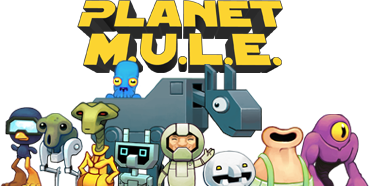|
Big Head Zach
|
 |
« on: January 03, 2010, 22:40 » |
|
Basic Elements of Play
LAND AND RESOURCES
At the beginning of the game, the Federation colony ship lands in an arbitrary portion of Planet Irata consisting of "plots" of land, arranged in a grid of 5 rows and 9 columns. The center column has a valley running north-south, in which a river flows. The very center of the map is literally the Town Square, where the colony lives and works, and contains various offices, outfitting stores, and the MULE Corral.
To harvest and collect the planet's resources, players must purchase MULEs from the Corral, outfit them for a specific resource at one of four stalls, and install them on plots of land.
Most of the plots on the map are flat plainland, but 2 plots on each row are guaranteed to contain mountainous terrain, indicated by 1-3 hilly peaks. Each type of terrain has its own unique qualities which can benefit/inhibit players' production of resources.
SMITHORE
Smithore is a durable metal used in the production of MULEs. Between game turns, the Store will build an additional MULE for every 2 units of Smithore it has, until it runs out of Smithore, builds 7 MULEs, or fills the Corral with 14 MULEs.
Smithore is most plentiful in the mountains (the more peaks the better), but there is still some to be found in the plains areas. You cannot mine for Smithore in the river valley due to erosion concerns.
Smithore prices vary between $35 and $260 per unit, but normally average around $50. The price of a MULE will always be 2x the current value of Smithore (2 units' worth). The cost to outfit a MULE for Smithore mining is $75.
FOOD
Food is what keeps you nourished and healthy; it determines how much time you have to move and perform actions during the Development Phase. During the first 4 rounds, you need 3 Food per round; in rounds 5-8, 4 Food per round; and in rounds 9-12, 5 Food per round. If you come up short, your time-bar will be reduced proportionately. If you have no Food, you'll only have 10% of your normal time (4.5 seconds)!
Food is best harvested in the river valley (fishing and irrigation), but also has decent returns in the plains. It can be found in small amounts in the mountains.
Food prices vary between $15 and $260 per unit, and usually stay pretty low unless there is a shortage. The cost to outfit a MULE for Food harvesting is $25.
ENERGY
Energy is used and consumed by MULEs to produce/harvest every type of resource except Energy itself. Each MULE that is not producing Energy requires 1 unit of Energy per round in order to operate. If you do not have enough Energy to power your MULEs in the Production Phase, you will not produce on a random non-Energy-producing plot for each unit of Energy you are short (marked by a dark lightning bolt symbol).
The best place to generate Energy is in the plains where winds are strong and solar exposure is highest. The river valley also provides decent Energy collection (hydrodynamic turbines). Mountains also provide a trickle of Energy, but it's very inefficient.
Energy prices vary between $10 and $260 per unit, but usually stay bottomed out unless there is a shortage. The cost to outfit a MULE for Energy collection is $50.
CRYSTITE
Crystite is a luxury mineral (like diamond) that has no practical purpose in colonization...but it's also quite rare in the rest of the galaxy, and so is worth quite a bit! All Crystite that is sold to the Store is immediately shipped off-world, and can't be bought except from other players. Consequently, Crystite is also a prime target of theft by piracy.
Crystite deposits are hidden underground, so there's no obvious indicator of where to find the best places to mine it. There are guaranteed to be 4 high-density "blooms" of Crystite underground, which start at random but specific places, and spread out in a circular pattern. The threat of erosion still prevents MULEs from mining in the river valley, but all other terrain may contain mineable deposits. Meteors from space tend to have a very high quantity of Crystite as well, if you happen to be the unfortunate(?) victim of one!
FAQ: I only saw three plots in a game that had High Crystite density. What happened to the 4th?
The "blooming points" of Crystite deposits can exist on the river valley or the Store, which means they are unmineable. However, the spreading effect of those blooms can still be seen in adjacent plots.
Crystite prices are not governed by the local laws of supply and demand; it varies in price between $48 and $148 each round, and you can never predict how the price will change between rounds. It costs $100 to outfit a MULE for Crystite mining.
STARTING OUT
After the colony ship lands, the town Store is stocked with 14 MULEs, 8 Smithore, 8 Food, and 8 Energy. Each player is also given a starting stake of 2 Energy, 4 Food, and $1000 in cash. Good luck to everyone!
SPEC: The original game's manual states that it takes a full turn for the Store to build MULEs from the Smithore it has. Unknown as to whether this is an out-and-out error, or misinterpretation, but as far as game code has deciphered, the Store uses both the Smithore it already possesses, plus whatever was sold to it in the round, to build MULEs. Further investigation of the original versions (Atari and C64 combined) also needs to determine whether the Store builds as many MULEs as it can (up to Corral limit), or a maximum of 7.
|
